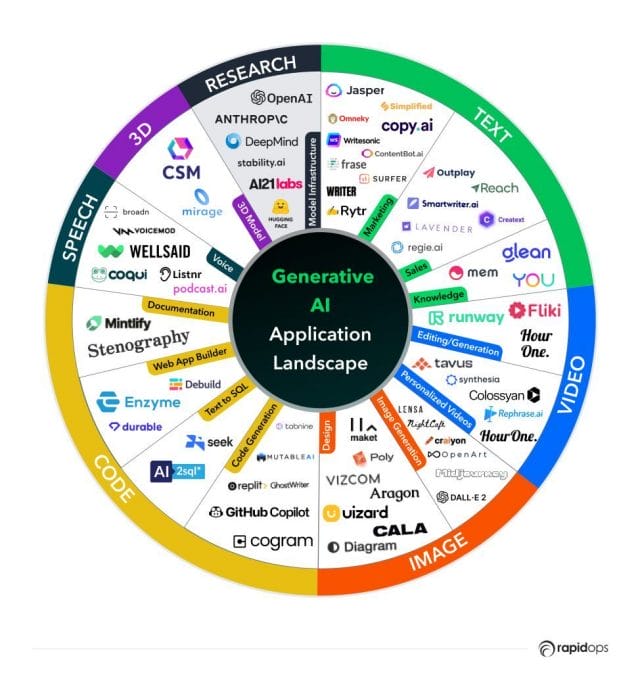by
I recently delivered a keynote presentation on the topic of “AI Driven Success: Embracing the Future of Business Today”. The presentation was well-received, and I have received numerous emails and messages from individuals interested in accessing the keynote and obtaining further information. In response to this demand, I decided to create a long-format blog post that expands on the content covered in the keynote. This blog post aims to provide a comprehensive resource for businesses looking to venture into the realm of AI. Thanks to all who attended!

In today’s rapidly evolving business landscape, the integration of artificial intelligence (AI) is poised to redefine success in unprecedented ways. As organizations continue to grapple with challenges presented by technological advancements, embracing AI-driven solutions has emerged as a paramount strategy for staying ahead of the competition. With its ability to streamline processes, optimize decision-making, and unlock untapped potential across various industries, AI represents the future of business. This article delves into the transformative power of AI and highlights why forward-thinking organizations are already harnessing its capabilities to drive exceptional growth and prosperity. By recognizing the immense opportunities presented by AI and boldly adopting this revolutionary technology today, businesses can position themselves at the forefront of innovation while reaping substantial rewards tomorrow.

What is AI?
Artificial intelligence (AI) refers to the ability of computer systems to perform tasks that typically require human intelligence. It involves the development of computer programs and algorithms capable of simulating human cognitive processes, such as learning, reasoning, problem-solving, and decision-making. AI encompasses a wide range of technologies and methodologies, including machine learning, natural language processing, computer vision, robotics, and expert systems. The integration of AI into business processes has become increasingly important as organizations seek innovative ways to gain a competitive edge in the digital age. By leveraging AI-driven solutions, businesses can automate routine tasks to increase operational efficiency and accuracy while enabling employees to focus on higher-value activities. Additionally, AI-powered analytics enable organizations to extract insights from vast amounts of data more effectively and make informed decisions faster. Moreover, AI holds immense potential for generating new revenue streams by unlocking untapped market opportunities. By analyzing customer behavior patterns and preferences through machine learning algorithms or personalizing recommendations using natural language processing techniques in chatbots or virtual assistants, companies can enhance their products and service offerings to better meet customer needs. Overall, AI represents an incredible tool for businesses looking towards the future — one that offers improved efficiency levels, enhanced decision-making capabilities, personalized customer experiences, and ultimately drives success in these rapidly evolving times.
History of AI
Artificial intelligence (AI) has a fascinating history that dates back to the early 20th century. Science fiction introduced the concept of intelligent robots, leading visionary thinkers like Alan Turing to explore the mathematical possibilities of AI. However, progress was hindered by technological limitations and high costs. It wasn’t until the 1956 Dartmouth Summer Research Project on Artificial Intelligence that significant advancements were made, bringing together researchers from various fields to discuss the potential of AI. From there, AI experienced a roller coaster ride of success and setbacks, with breakthroughs in algorithmic techniques and increased funding reigniting interest in the field.
Between 1957 and 1974, AI flourished as computers became faster, cheaper, and more accessible. Early demonstrations showcased problem-solving skills and speech recognition capabilities. Government agencies like DARPA funded AI research, fueled by optimism and high expectations. However, computational power remained a significant obstacle to achieving advanced goals like natural language processing and self-recognition. The lack of funding during the following decade slowed down research progress until the 1980s when algorithmic advancements and renewed financial support revitalized the field. Landmark achievements such as defeating world chess champion Gary Kasparov solidified AI’s potential while advancements continue to shape its future.
In recent years, AI has become an integral part of our lives due to advancements in big data collection and massive computing power. Industries like technology, banking, marketing, and entertainment have leveraged AI’s ability to process vast amounts of information through brute-force learning algorithms. As we move forward, AI language is emerging as a prominent development area for machines capable of engaging in fluid conversations or real-time translation between languages. Driverless cars are also becoming a reality within the next two decades. While achieving general intelligence that surpasses human cognition seems inconceivable in the near future due to ethical considerations, steady improvement continues to allow AI to have a profound impact on society.
Overall, the history of AI has been marked by ups and downs, but it has continuously evolved thanks to technological advancements and increased funding. From theoretical discussions to practical applications, AI has come a long way. As we embrace the age of big data, AI’s role in various industries is becoming more prevalent. While we await further breakthroughs and navigate ethical challenges, there is no doubt that AI will continue to shape our world in ways we couldn’t have imagined just a few decades ago.

Types of AI
AI can be classified into three types: Narrow AI, General AI, and Super AI. Narrow AI focuses on specific tasks and has limitations beyond which it cannot perform. Examples include Apple Siri and IBM Watson. General AI, on the other hand, aims to understand and learn any intellectual task just like a human being. However, achieving General AI is still a challenge for researchers. Lastly, Super AI surpasses human intelligence and excels in performing tasks better than humans. While the concept of Super AI is hypothetical, it holds the potential for advanced thinking and decision-making abilities.
In terms of functionalities, there are four types of Artificial Intelligence: Reactive Machines, Limited Memory, Theory of Mind, and Self-awareness. Reactive Machines operate based on present data without storing memories or using past experiences. An example is IBM’s Deep Blue which defeated chess grandmaster Garry Kasparov. Limited Memory AI trains from past data but has short-lived memory compared to long-term storage like humans. Theory of Mind AI represents an advanced concept where machines have a deep understanding of people’s emotions and thoughts but is not fully developed yet. Self-awareness AI exists hypothetically and would possess internal traits like emotions and beliefs.
Apart from these types, there are several branches of AI such as Machine Learning, Deep Learning, Natural Language Processing (NLP), Robotics, and Expert Systems. These branches focus on specific areas like learning algorithms from data (Machine Learning), acquiring knowledge through neural networks (Deep Learning), interaction between computers and human language (NLP), robot design and operation (Robotics), and mimicking human reasoning for decision-making (Expert Systems).
AI has transformed various industries and continues to evolve. While Super AI and Self-awareness AI are still hypothetical, Narrow AI and General AI have already made significant advancements. Understanding the different types and branches of Artificial Intelligence helps us comprehend its potential in solving complex problems and making informed decisions.

How Does AI Work?
Machine Learning, Deep Learning, and Natural Language Processing (NLP) are three interconnected fields that have revolutionized the way computers process and understand data.
1. Machine Learning: Machine Learning is a subset of Artificial Intelligence (AI) that focuses on developing algorithms and models that enable computers to learn from data without being explicitly programmed. It involves training a computer system on a large amount of data and allowing it to automatically learn patterns and make predictions or decisions based on that learned knowledge. Machine Learning techniques are widely used in various domains, such as image recognition, fraud detection, recommendation systems, and more.
2. Deep Learning: Deep Learning is a subfield of Machine Learning that uses artificial neural networks to model and understand complex patterns in large datasets. Inspired by the structure of the human brain, deep learning models consist of multiple layers of interconnected nodes called neurons. These neural networks can analyze vast amounts of data with multiple layers of abstraction, enabling them to extract features automatically without manual feature engineering. Deep Learning has achieved remarkable success in areas like image classification, speech recognition, natural language understanding, and autonomous driving.
3. Natural Language Processing: Natural Language Processing (NLP) focuses on enabling computers to understand and interpret human language in a way that is meaningful to humans. NLP techniques combine elements from linguistics, statistics, and machine learning to process and analyze text or speech data. It involves tasks like sentiment analysis, named entity recognition, machine translation, question answering systems, chatbots, and more. NLP algorithms tackle challenges such as understanding context, disambiguating meanings from words or phrases, and generating coherent responses.
4. Interplay between ML, DL & NLP: The interplay between Machine Learning (ML), Deep Learning (DL), and Natural Language Processing (NLP) is evident in many applications today. For example, in an automated speech recognition system powered by NLP techniques for transcribing spoken language, Deep Learning models are often used to extract relevant features and patterns. These models are trained using large amounts of labeled data through Machine Learning algorithms. In turn, the accuracy of these ML and DL models improves over time as more data is fed into the system. This synergy between ML, DL, and NLP has paved the way for significant advancements in various fields, including virtual assistants, language translation services, sentiment analysis tools, and much more.
Large Language Models
Large language models (LLMs) are advanced deep learning models that have revolutionized the field of natural language processing. These models are trained to understand and generate text in a human-like fashion, making them incredibly useful in various applications. One of the main benefits of LLMs is their ability to process and analyze large amounts of text data, allowing them to extract meaningful information and insights from vast corpora of text. This makes them invaluable for tasks such as information retrieval, sentiment analysis, text generation, translation, summarization, and question answering.
One key advantage of LLMs is their structure based on transformer models. The transformer architecture introduced by Vaswani et al. in 2017 has greatly improved the performance and efficiency of language processing models. Unlike traditional recurrent neural networks (RNNs), transformers use attention mechanisms that enable them to capture long-range dependencies between words in a sentence or document. This holistic approach allows LLMs to have a better understanding of the context and meaning behind words, resulting in more accurate predictions and higher-quality generated text.
Another benefit of LLMs is their capacity to generate text autoregressively based on previously generated tokens. By leveraging clues from the original input or previous outputs, LLMs can produce coherent and contextually relevant responses or paragraphs. This makes them ideal for tasks like generating blog posts, where consistency and fluency are crucial. Moreover, because LLMs learn from vast amounts of training data that cover various topics and styles, they can produce text in different writing styles or mimic the characteristics of specific authors.
Overall, large language models provide numerous advantages for blog posts or any other application involving natural language processing. They offer improved text understanding capabilities compared to earlier models thanks to transformer architectures and attention mechanisms. They can generate high-quality text by leveraging autoregressive generation techniques. And with their ability to process massive amounts of training data from diverse sources, they possess broad knowledge and can adapt to different writing styles. By harnessing the power of large language models, bloggers and content creators can enhance their writing process, improve text quality, and deliver more engaging and informative content to their readers.

Use Cases of LLM AI
Large language models (LLMs) offer small businesses a wide range of practical use cases to improve their operations and achieve growth. From content creation and marketing to customer support, SEO optimization, content moderation, and sales support, LLMs provide powerful tools that can streamline processes, enhance customer experiences, and drive business success. These versatile models enable small businesses to leverage advanced AI capabilities in areas such as language translation, sentiment analysis, virtual collaboration, recruitment and HR assistance, and fraud detection. By harnessing the power of LLMs, small businesses can unlock new opportunities for efficiency, innovation, and competitiveness in today’s dynamic business landscape.
- Content creation and marketing: Large language models (LLMs) offer small businesses a powerful tool for content creation and marketing. These models can generate high-quality content across various formats, such as blog posts, product descriptions, and social media posts. By leveraging LLMs, small businesses can save time and resources while still maintaining a consistent content strategy that resonates with their target audience. Additionally, LLMs can provide real-time suggestions for grammar, style improvements, and alternative phrasing, ensuring the produced content is polished and engaging.
- Customer support and engagement: Excellent customer service is crucial for small businesses to build strong relationships with their customers. LLM-powered chatbots can play a significant role in automating customer interactions by responding to inquiries, providing information, troubleshooting guidance, and handling typical customer service requests 24/7. This not only enhances the customer experience but also frees up valuable time for small business owners or support staff to focus on other essential tasks. With LLM-based chatbots, small businesses can effectively engage with customers at any time, improving satisfaction levels and building brand loyalty.
- SEO optimization: Search engine optimization (SEO) is vital for small businesses to improve their online visibility and attract organic traffic to their websites. LLMs can assist in optimizing content by suggesting relevant keywords and long-tail keywords that enhance the visibility of the content in search results. These models can also identify common search queries used by users, allowing small businesses to tailor their content accordingly. Furthermore, LLMs help optimize meta descriptions and tags for better click-through rates on search results pages. By incorporating LLMs into their SEO strategies, small businesses can improve their website’s ranking in search results and drive more targeted traffic.
- Content moderation: Large language models play a significant role in automated content moderation across various platforms for small businesses. They efficiently detect issues like offensive language, hate speech, threats, fake news, spam, and other forms of unwanted or inappropriate content. With LLMs, small businesses can ensure a safe online environment for users by flagging inappropriate content for further review or automatically removing it based on predefined moderation guidelines. However, it’s important to note that human oversight is still necessary for handling complex cases where context and nuance are crucial.
- Sales support: Large language models empower small businesses in various aspects of the sales process. They can assist in lead identification by analyzing customer profiles, online behavior, and social media interactions to identify potential leads with a higher likelihood of conversion. LLM-powered AI chatbots enable personalized sales outreach by engaging website visitors, collecting relevant information, providing insights to sales teams, and generating leads. Additionally, these models help analyze customer feedback and pain points to personalize sales approaches and build stronger relationships. By leveraging LLMs for sales support, small businesses can enhance their overall sales effectiveness and drive better results.
Statistics
According to a recent survey conducted by ResumeBuilder.com, the adoption of ChatGPT, an AI chatbot, is on the rise among businesses. The survey, which gathered insights from 1,000 U.S. business leaders, reveals several key statistics regarding the use and impact of ChatGPT in the workplace. Notably, 49% of companies currently utilize ChatGPT, with an additional 30% planning to implement it in the future. This article delves into the survey findings, shedding light on the ways in which ChatGPT is transforming job roles, saving costs, and influencing hiring practices.
- 49% of companies currently use ChatGPT, and 30% plan to use it in the future.
- 48% of companies using ChatGPT have replaced workers.
- 25% of companies using ChatGPT have already saved $75k or more.
- 93% of current users plan to expand their use of ChatGPT.
- 90% of business leaders believe that having ChatGPT experience is beneficial for job seekers.
- 66% of companies use ChatGPT for writing code, 58% for copywriting/content creation, 57% for customer support, and 52% for creating summaries of meetings or documents.
- 77% of companies find ChatGPT helpful in writing job descriptions, 66% in drafting interview requisitions, and 65% in responding to applicants.
- 55% of business leaders say the quality of work produced by ChatGPT is ‘excellent,’ and 34% say it’s ‘very good.’
- 48% of companies have replaced workers with ChatGPT since November 2022.
- 33% of business leaders believe that ChatGPT will definitely lead to layoffs by the end of 2023, and 26% say it will probably lead to layoffs.
- 63% of business leaders believe that within 5 years, ChatGPT will definitely or probably lead to worker layoffs.
- 99% of companies using ChatGPT say they have saved money.
- 92% of business leaders consider AI/chatbot experience as a plus when assessing candidates to hire, and 90% believe that ChatGPT-specific experience is beneficial.
- 48% of companies have saved more than $50,000, and 11% have saved over $100,000 using ChatGPT.
In today’s rapidly evolving business landscape, companies are embracing the power of conversational AI tools like ChatGPT to transform their operations and redefine the way they engage with customers. Large Language Models (LLMs) are being incorporated into various industries, offering a plethora of innovative use cases. Expedia, for example, has integrated conversational AI assistance into its travel-planning services. Customers can now plan their vacations by simply chatting with a virtual travel agent, receiving personalized recommendations and smart lists of hotels and attractions.
Microsoft, a long-time advocate of LLMs, has taken their integration to the next level. The company has harnessed the power of LLMs to enhance its Bing search engine, enabling users to search and receive results through a conversational interface. This intuitive approach revolutionizes the traditional search experience by providing users with more interactive and engaging interactions. Microsoft is also exploring the integration of LLM technology across its suite of software services, such as Word and Excel, to further augment productivity and efficiency.
Duolingo, the language education specialist, has leveraged LLMs to enhance its learning platform. With the introduction of GPT-4, Duolingo has launched features like Duolingo Max, which provides students with detailed explanations of their practice or test answers. This personalized feedback, delivered in natural language, simulates the experience of learning from a human tutor. Additionally, students can now engage with AI personas on the platform, interacting with them in role-playing scenarios to practice language skills.
The impact of LLMs is not limited to travel, technology, and education sectors. Companies like Coca Cola have partnered with consultancy firms to utilize LLMs for crafting personalized ad copy, images, and messaging. By harnessing the capabilities of LLMs, Coca Cola aims to create unique and tailored customer experiences. From customer service automation to workflow management and marketing personalization, the integration of LLMs into businesses is driving efficiency, boosting productivity, and redefining how companies interact with their audiences.
How to start utilizing AI today
To start utilizing AI today, organizations should begin by identifying the specific areas within their operations that could benefit from AI-driven solutions. This could range from customer service and marketing to supply chain management and data analysis. Once these areas have been identified, it is crucial to select the right AI technologies or platforms that align with the organization’s goals and resources.
Next, businesses should invest in building a strong foundation for AI implementation by ensuring they have reliable data infrastructure. This involves collecting high-quality data, cleaning and organizing it effectively, as well as implementing robust security measures to protect sensitive information.
Lastly, organizations should involve key stakeholders early on in the process of integrating AI into their operations. By educating employees about the benefits of AI technology and providing adequate training opportunities, businesses can ensure a smooth transition and foster a collaborative work environment conducive to innovation.
By following these steps, organizations can start leveraging artificial intelligence today and position themselves at the forefront of industry transformation.

Getting Started
Using ChatGPT: Using ChatGPT is simple and straightforward. All you need is an OpenAI account and a web browser. Once you’re logged in, you can start interacting with the AI chatbot. ChatGPT can help you with a variety of tasks, such as drafting messages, creating content, answering questions, and engaging in casual conversations. Its advanced natural language processing capabilities ensure relevant and coherent responses, making it a valuable tool for enhancing digital communication and automating text-based tasks.
ChatGPT Plus: OpenAI offers a subscription plan called ChatGPT Plus for users who want additional benefits and an enhanced experience. For a monthly fee of $20, subscribers gain access to faster response times, priority access to new features, improvements, and increased API usage limits. ChatGPT Plus is designed to provide users with the best possible results and ensure a seamless interaction with the AI chatbot.
Integration and Potential: ChatGPT is not limited to standalone usage. Developers can utilize the cloud-based API to integrate ChatGPT into their own applications and create customized AI solutions. This opens up a world of possibilities, including building chatbots, virtual assistants, language translation services, and more. Even for non-developers, there are user-friendly platforms and applications available that utilize ChatGPT, making it accessible to individuals who want to automate tasks and generate content without any coding knowledge.
ChatGPT has quickly become a game-changer in the world of AI. Its user-friendly interface, advanced language processing capabilities, and versatility make it a valuable tool for various tasks. Whether you’re a developer exploring the API or an individual seeking efficient ways to automate and streamline your work, ChatGPT offers a wide range of possibilities. With the option to upgrade to ChatGPT Plus for an enhanced experience, the potential of integrating ChatGPT into applications, and the availability of user-friendly platforms, now is the perfect time to dive into the world of ChatGPT and harness its power.
Whats next?
The release of GPT-4 has opened up a world of possibilities for the future of AI language models. With its significant advancements over previous models, the question arises: what’s next for GPT-4?
- Refinement and Optimization: As with any new technology, GPT-4 will undergo continuous refinement and optimization. OpenAI will gather feedback from users, identify areas for improvement, and fine-tune the model to enhance its performance. This iterative process will ensure that GPT-4 becomes even more reliable, creative, and effective in understanding nuanced prompts.
- Broadening Language Support: While GPT-4 already supports a wide range of languages, OpenAI will likely continue to expand its language capabilities. This means incorporating more languages into the model to cater to a diverse user base across the globe. The goal is to make GPT-4 accessible and useful to people from different linguistic backgrounds.
- Integration into More Applications: GPT-4’s multimodal capabilities make it a powerful tool for various applications beyond text generation. We can expect to see its integration into more platforms and services, enabling users to interact with AI in new and exciting ways. From intelligent learning platforms to assistive technologies, GPT-4 has the potential to revolutionize how we engage with AI in our daily lives.
- Ethical Considerations and Safeguards: As AI language models become more sophisticated, ethical considerations and safeguards become increasingly important. OpenAI will continue to address concerns such as bias, misinformation, and the responsible use of AI. It will strive to make GPT-4 more reliable, accountable, and transparent, ensuring that it aligns with ethical standards and benefits society as a whole.




